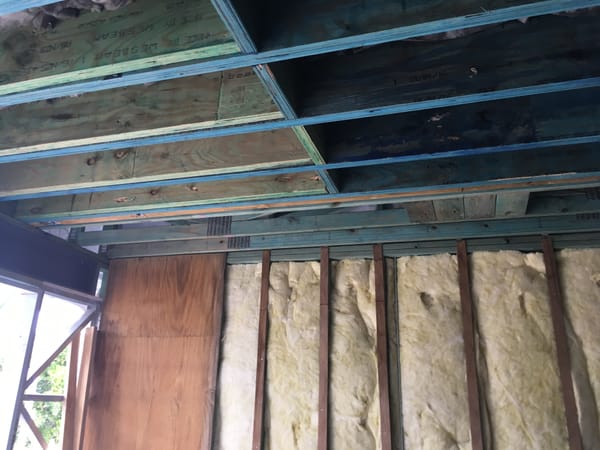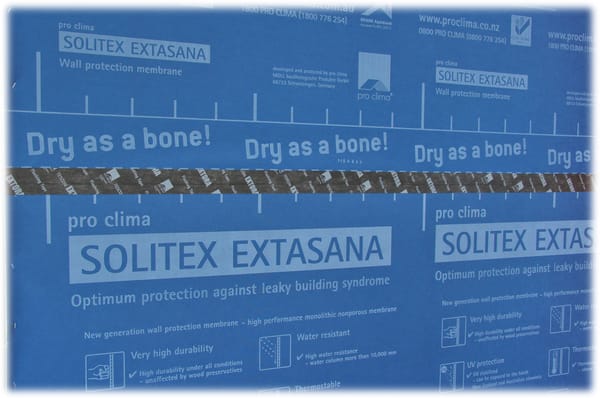Take The Quiz On This Post
Read the post, then take the quiz—test your knowledge and see what you’ve learned!
Introduction
You've saved up and decided to build your dream home. Congratulations! Now comes the big question: how do you ensure it's energy efficient and high-performance so you can enjoy lower utility bills and a comfortable space for years to come? The secret lies in addressing the four control layers during construction.
As an informed home buyer, you must understand these layers and how professional builders implement them to achieve optimal building energy efficiency.

Understanding the 4 Control Layers for Energy Efficient Homes
To build an energy-efficient home, you need to consider how the four main control layers - water, air, vapour and thermal - interact and impact the performance of your home.
Water control aims to prevent damage from rain, leaks or spills. Things like waterproofing membranes (wall wrap/building paper), gutters, downpipes, water tanks, gray water systems and stormwater drainage all help manage water flow in and around your home.
Air control regulates air flow through your home using devices like exhaust fans, air vents, trickle vents, rain screens and heat recovery ventilation systems (HRVs). Proper air control removes pollutants and maintains good indoor air quality and thermal comfort.
Vapour control prevents excess moisture build-up inside walls and ceilings. Things like vapour barriers, insulation, ventilation, and waterproofing all work together to control vapour and prevent issues like mould growth or structural damage.
Thermal control aims to keep temperatures at comfortable levels. Insulation, glazing, shading, heating and cooling systems are all used to control heat flow into and out of your home. Optimising the thermal performance means lower energy bills and a more comfortable living environment.
By considering all four control layers during the design and construction process, builders can achieve optimal energy efficiency and performance in their homes. Focused effort and attention to detail for each control layer will result in high-performance homes that are durable, comfortable and affordable to operate.
How Air Reticulation Systems Help Manage the Air Control Layer
An air reticulation system, like a heat recovery ventilator (HRV) or energy recovery ventilator (ERV), is key to managing the air control layer in high-performance homes. These systems filter and circulate fresh air throughout the home while recovering 60-95% of the energy from the stale air being exhausted.
Read another article on this topic here:
- Understanding and Managing Condensation in Buildings
- Build an Energy-Efficient Home: Air Sealing and Insulation Details
HRVs vs. ERVs
HRVs and ERVs differ in how they handle moisture. An HRV transfers heat but not moisture between the incoming and outgoing air streams. An ERV transfers both heat and moisture. In humid climates, an ERV may be better to prevent excess moisture buildup indoors. An HRV is typically suitable in dry climates and helps avoid drying out the air.
Benefits of Air Reticulation
Proper ventilation and air circulation provide many benefits:
- Removes pollutants like VOCs, allergens and carbon dioxide
- Prevents excess humidity, which can lead to mould growth
- Distributes heated or cooled air evenly for comfort
- Recovers energy, which reduces heating/cooling costs
- Provides fresh air for better indoor air quality and occupant health
Read another article on this topic here:
Maintenance
While air reticulation systems are low-maintenance, filters should be inspected regularly and changed when dirty. Outdoor air intakes and exhausts should also be checked to ensure they're clear of any obstructions. An HVAC technician can perform periodic maintenance to keep your system running efficiently and address any issues early on.
With the right equipment and maintenance, an air reticulation system will provide high-performance homes with optimal ventilation, energy efficiency, and a healthy indoor environment for years to come. The benefits to builders and home owners alike make investing in air reticulation worthwhile.
Achieving Thermal Comfort Through Proper Insulation and HVAC
Project builders must focus on proper insulation and HVAC (heating, ventilation and air conditioning) to achieve optimal thermal comfort.
Insulation
Adding insulation creates an effective thermal barrier, preventing heat transfer between the inside and outside of your home. Fibreglass batts or rolls, cellulose, and rock wool are the most common types used in new home construction. Fibreglass and cellulose trap air pockets, while spray foam expands to seal and insulate the area.
Project builders will insulate exterior walls, attics, basements, and crawl spaces according to the climate zone the home is located in. More insulation is needed in extremely hot or cold areas. Proper insulation can improve comfort, lower energy usage, and save money for the lifetime of the home (see this article and this one for more reading on this topic).
HVAC
HVAC systems control your home's ambient temperature, humidity, and air quality. Project builders will install efficient systems sized for the home's square footage and insulation level. This helps ensure consistent heating and cooling while using minimal energy.
The latest HVAC technologies - like geothermal heat pumps, smart thermostats, and Energy Star-rated systems - can significantly boost the energy efficiency of any home. Geothermal systems tap into the consistent temperature below ground, smart thermostats can optimise start/stop times, and Energy Star ratings indicate high-performance, eco-friendly units.
By focusing on insulation, HVAC, and the latest green building standards, project builders are able to achieve optimal thermal comfort and energy efficiency in the homes they construct. Home owners benefit from lower utility bills, a healthier indoor environment, and peace of mind knowing they're reducing their environmental impact.
Controlling Moisture With Vapour Barriers and Mechanical Ventilation
Controlling moisture in your home is key to energy efficiency and comfort. Excess moisture can lead to mould growth, structural damage, and high utility bills. Project builders often install vapour barriers and mechanical ventilation systems to manage moisture properly.
Vapour Barriers
Vapour barriers block water vapour from passing through walls and ceilings. Common vapour barriers for homes include polyethylene sheeting and vapour-retardant paints or gyprock. When appropriately installed, vapour barriers prevent moist indoor air from penetrating walls and condensing.
Mechanical Ventilation
Mechanical ventilation systems, like heat recovery ventilators (HRVs) or energy recovery ventilators (ERVs), continuously exhaust stale, moist air from your home and bring in fresh air from outside. These systems can significantly improve indoor air quality and reduce excess moisture. HRVs and ERVs recover energy from the exhaust air to help condition the incoming fresh air, which helps maximise efficiency.
For the best moisture control, consider the following in your new home build:
- Install vapour barriers on all exterior walls, especially in rooms with a lot of moisture, like bathrooms, kitchens and laundry rooms. Make sure all seams and penetrations are adequately sealed, lapped (by at least 150mm) and secured.
- Install a rain screen behind the external cladding, including a head and sill core vent (with bug screen) to allow air circulation. This removes any moisture that may pass through the cladding through evaporative cooling/drying and increases the performance and longevity of applied coatings (paint), reducing maintenance costs.
- Choose an HRV or ERV system sized for your home. Run the system continuously at a low speed for the best moisture removal and energy efficiency. Increase the speed when high levels of moisture are expected like during showers. See this article for more information about HRV/ERV systems - 12 Benefits of installing a ventilation system in your new home.
- Consider installing additional exhaust fans in moisture-prone areas like over the stove range or bathrooms. Run these fans as needed to remove excess moisture at the source.
- Choose building materials that won't promote or trap moisture, like water-resistant gyprock, water-resistant flooring, paint, rain screens behind cladding and moisture-wicking insulation (Rockwool is great).
- Monitor humidity levels in your home and aim for 30-50% relative humidity for the most comfortable and efficient environment. Use a humidifier or dehumidifier to adjust as needed.
Controlling moisture through multiple techniques will result in a high-performance, energy-efficient home that's built to last. Work with your builder to determine the right combination of vapour barriers, ventilation, and materials for your new home.

Working With Project Builders to Optimise Building Science and Energy Efficiency
Working with a reputable project builder is key to achieving an energy-efficient new home. The best builders focus on optimising the four control layers: water, air, vapour and thermal. Getting these right means your home will be comfortable, affordable to run and better for the environment.
When planning your home with a builder, ask how they incorporate building science principles for energy efficiency and sustainability. Things to consider include:
Water control
Proper water control, or moisture management, prevents excess humidity that can lead to mould growth or water damage. Builders should use weather-resistant materials, install wide/vented eaves and use downpipes and yard gullies to channel water away from the home. Include features like roof ventilation (we recommend fixed roof vents over rotary vents- cheap and prone to breakage after a few years) to reduce ambient roof space temperatures.
Learn more about what eaves are here and their purpose in your home.
Air control
An energy-efficient home has controlled airflow. High-performance builders will install an HRV (heat recovery ventilator) or ERV (energy recovery ventilator) to circulate fresh air while recovering heating/cooling already used. They’ll also seal and insulate to reduce air leaks. Things like weather stripping doors and using spray foam insulation help control airflow.
Vapour control
Water vapour from showers, cooking, and breathing can accumulate in a home. Builders should install vapour barriers behind gyprock and under floors to prevent vapour diffusion into building materials.
Thermal control
A thermally controlled home maintains a comfortable temperature. High-performance builders will maximise insulation, install double or triple-glazed windows, and consider passive solar design. They may also use sustainable materials with high thermal mass, like concrete floors, to help regulate temperature.
Working with an experienced builder focused on building science means optimising a home for efficiency. Ask prospective builders about their approach to the four control layers. The more steps they take to improve water, air, vapour and thermal control, the more comfortable and energy-efficient your new home will be.
Conclusion
So there you have it, the four control layers determining how efficient and high-performance your new home will be. As you choose a builder for your new construction, ensure they have a solid understanding of these components.
Ask about the strategies and technologies they plan to implement to optimise each control layer. Your builder should be focused on maximising the performance of your home so you can enjoy lower energy bills, improved indoor air quality, and a more comfortable living environment for years to come. Take control of your home's performance and choose a builder who will prioritise it.
The future is high-performance building envelopes!







